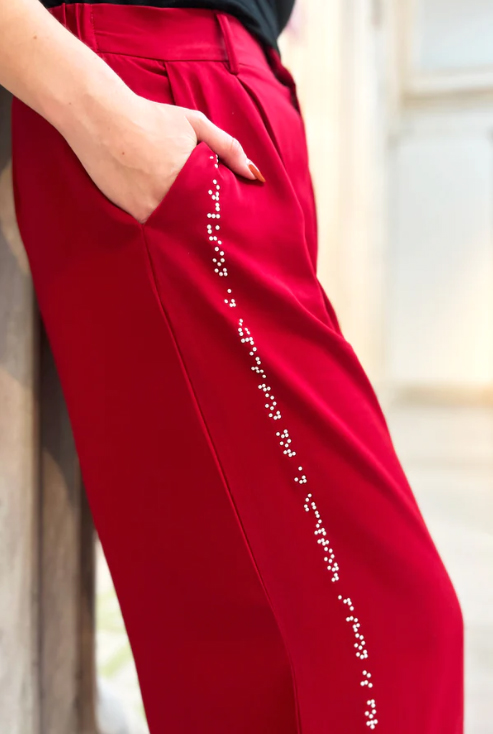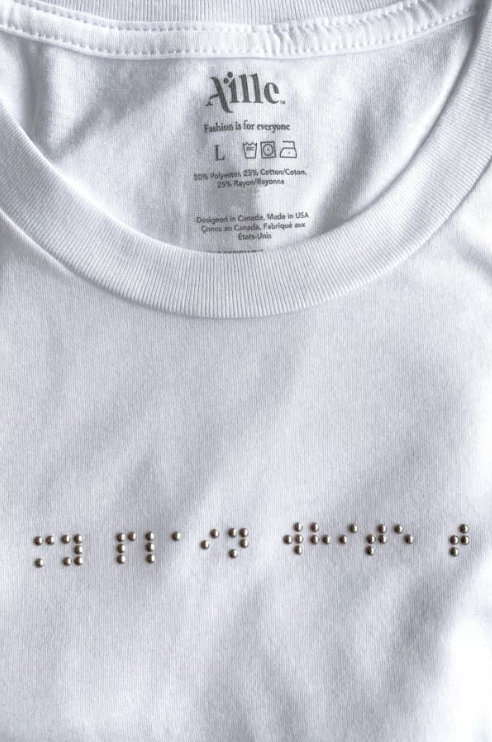Fashion for All: Making Style Accessible to Individuals with Disabilities
Exploring the rise of adaptive clothing and inclusive fashion initiatives
By Diana Jordan, Assistant Digital Media Editor, Media/Communications

introduced a braille-embossed
clothing line, including pants
(pictured here) and t-shirts (in
photo below). Photo credit: Aille
Design.
Fashion is a form of self-expression that to most people, holds no boundaries. Although styles have evolved tremendously over the years, it is only recently that the clothing industry has begun to prioritize accessibility, particularly for individuals with disabilities. New York Fashion Week, held from February 9 to 16, 2024, is an exciting time for brands and designers to get a chance to show off their new projects on the runway. It’s also a proud moment for people with disabilities, who are starting to be represented on the runway with models in wheelchairs, prosthetics, or with limb differences.
Adaptive clothing has emerged as a crucial component of accessible fashion, designed to provide ease and comfort for individuals facing mobility and other challenges. Nowadays, up-and-coming designers are exploring ways to create inclusive fashion pieces. Some have introduced lines of clothes catering to the needs of individuals with disabilities, ensuring that everyone can express their own style. Designer Vongai Noreen Ruzive, founder of VonRuz, started a brand that has easy fastening blazers, pants, and skirts for women in wheelchairs. Alexa Jovanovic, founder of Aille Design, established the first fashion brand to feature braille on its clothing for individuals who are visually impaired. Designer Sema Gedik, CEO and founder of AUF AUGENHOEHE, created the first label for little people. People with dwarfism often experience other physical and health issues like numbness or pain from spinal stenosis – a condition in which the opening in the spinal column is too small to accommodate the spinal cord, according to Little People of America.
But what about notable brands in the fashion industry? Have they created any adaptive styles? In fact, Nike's "FlyEase" line, first launched in 2015, features sneakers with a bi-stable hinge that allows the shoe to be both fully opened and fully closed, hands-free. The entire heel, including the sole, hinges open to allow the foot to slip in, then step down to make the heel move back into place and secure the foot. This shoe was inspired by people with cerebral palsy and individuals who sustained a stroke and have reduced mobility. The design allows people of all abilities to easily slip on and off their shoes without using their hands. Nike now offers four different types of FlyEase shoes.
Victoria's Secret has recently taken strides to support women with disabilities by launching a new adaptive fashion line. This line offers undergarments featuring soft fabrics and magnetic closures for amputees or individuals in wheelchairs who may not be able to stand or lift their arms to put on undergarments, shirts, or pants. Some of the wearables can also be adjusted for medical equipment – such as a feeding tube or oxygen tank.

Research from Kessler Foundation’s Center for Spinal Cord Injury Research shows that individuals with spinal cord injury often have issues with self-care, including dressing themselves. Donning a piece of clothing on their own can be challenging and may require a lot of practice or use of adaptive tools like a button pull for shirts and pants. Adaptive clothing with magnetic closures and stretchy fabrics may provide better accessibility to help individuals dress themselves independently.
Another notable brand, Tommy Hilfiger, is producing tag-less shirts with flat seams to address sensory concerns, along with dress shirts featuring magnetic buttons for quick and simple closure. Research from the Center for Autism Research at Kessler Foundation explains that individuals with autism may struggle with sensory concerns, like hypersensitivity to certain clothing fabrics or textures. These individuals may find tag-less, flat-seamed clothing more comfortable than traditional shirts.
With the rise of adaptive clothing design becoming more readily available, higher education has taken the hint and started evolving its programs to become inclusive as well. Parsons School of Design in New York, NY, is offering “The Parsons Disabled Fashion Student Program,” a scholarship and mentorship initiative to support people with disabilities interested in earning a fashion degree and entering the industry. With this scholarship, students with disabilities will be able to afford tuition and living expenses, as well as peer-to-peer community and support networks that aim to make attending Parsons more inclusive.
Recent fashion innovations and emerging trends reflect the ongoing transformation of the fashion industry into a more disability-inclusive realm, highlighting significant advancements.
In search of other accessible clothing brands? Here’s a link to one article by Accessiblity.com, with a list of the best adaptive clothing brands for every style, body, and budget.
